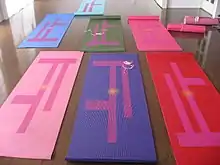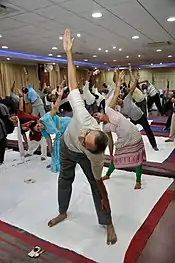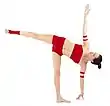Yoga mat
Yoga mats are specially fabricated mats used to prevent hands and feet slipping during asana practice in modern yoga as exercise. An early variety made of rubber carpet underlay, pioneered by the yoga teacher Angela Farmer in 1982, was called a sticky mat.

Before modern times, meditative yoga and hatha yoga were practised on bare ground, sometimes with a deer or tiger skin rug. Modern mats suitable for energetic forms of yoga are made of plastic, rubber, and sometimes other materials including hessian and cork, trading off cost, comfort, grip, and weight.
The yoga mat has been called "One of the most ubiquitous symbols of yoga's commercialization".[1]
History
In ancient times, yoga was practised in India on kusha grass, on hard earth without any cover, or on a rug of deer or tiger skin, as specified in the Bhagavadgita and the Shvetashvatara Upanishad as suitable for attaining enlightenment.[2][3][4]
Seated in an easy posture, on a (deer or tiger) skin, placed on Kusha grass, worshipping Ganapati with fruits and sweetmeats, placing the right palm on the left, holding the throat and head in the same line, the lips closed and firm, facing the east or the north, the eyes fixed on the tip of the nose, avoiding too much food or fasting, the Nâdis should be purified, without which the practice will be fruitless.
— Shvetashvatara Upanishad, chapter II
Due to the scarcity and cost of such rugs,[5] they are now rarely used even in India.[6]

With yoga's introduction in the West, many practitioners used towels or cotton mats on wooden floors.[7] Feet tended to skid on these surfaces, requiring strength just to stand still in a pose like Trikonasana.[8] In 1982, while teaching yoga in Germany, Angela Farmer used carpet underlay cut to towel size during yoga classes; she returned home to London with the material. Angela's father, Richard Farmer, contacted the German padding manufacturer and became the first retailer of "sticky mats".[9] The first purpose-made yoga mat was manufactured and sold by Hugger Mugger Yoga Products in the 1990s; the company initially imported Farmer-style mats, but finding that they began to crumble with use, developed their own more robust alternative.[10][11]
Types

Yoga mats are normally around 6 feet (180 cm) long and have a width of 2 feet (61 cm). Yoga mats range in thickness from lightweight 1⁄16 inch (2 mm) to 1⁄8 inch (3 mm) (standard) and up to 1⁄4 inch (6 mm) for either high performance mats or soft mats for yoga therapy.[12]
Yoga mats are available in many colors and patterns. "Alignment mats" are printed with guides to proper alignment, helping the yogi to place his or her feet the right distance apart and accurately in line with each other. Some companies print custom images on mats, especially the more expensive ones.[12] Some travel mats can be folded into a small square.[13][14]
The first commercially produced "sticky"[12] yoga mats were made from PVC; they have a smooth surface, and tend to be cheaper.[12] More recently, some supposedly "eco-friendly"[12] mats are being made from natural jute, organic cotton, and rubber.[12] PVC mats are the spongiest, resulting in more "give" when stepped on; fibre mats such as cotton and jute are the firmest.[12] Jute mats are the roughest; "sticky" PVC mats give good grip, but some of the modern textured mats in other materials also grip well.[12][15] Smooth mats provide the most grip, so are suitable for the more energetic styles such as hot yoga and Ashtanga vinyasa yoga; the trade-off is that they may be less comfortable and appear dirty more quickly. Mats with more texture can provide more padding, useful for styles such as yin yoga where poses are held for longer periods. Travel mats are thinner and lighter, but provide less padding.[16]
Yoga Journal asked five yoga professionals for their views on yoga mats. They varied widely in their brand preferences, some choosing the traditional "sticky" type, but they agreed that mats must not be slippery.[13]
A hessian mat reviewed by The Independent gave good grip and was both comfortable and attractive; its rubber underside made it stable on any surface, but somewhat heavy; a cork mat provided both good grip and an exceptionally warm surface with a pleasant texture, and the property of being to some degree self-cleaning.[16] The best grip was given by a smooth latex mat; in the review's opinion, its 4 mm thickness both gave enough padding for yin yoga, and the stability for energetic yoga styles.[16] The review noted that a circular mat was at first unfamiliar, but helpful for personal practice of poses such as Prasārita Pādottānāsana (wide stance forward bend) and sequences where a rectangular mat would have to be turned through 90 degrees at intervals; it was also ideal for demonstrating asanas to a class.[16]
In popular culture
.jpg.webp)
The yoga mat has become the definitive symbol of modern yoga as exercise.[8] The journalist Ann Louise Bardach wrote in The New York Times in 2011 that "precious few of the estimated 16 million supple, spandex-clad yoginis in the United States, who sustain an annual $6 billion industry, seem to have a clue that they owe their yoga mats to Vivekananda."[17][18] The yoga scholar Andrea Jain wrote in The Washington Post that "One of the most ubiquitous symbols of yoga's commercialization is the mat, which many consider a necessity to prevent slipping, to mark territory in crowded classes or to create a ritual space."[1] She noted that "committed adherents" could pay over $100 for a luxury mat.[1] The yoga scholar Noora-Helena Korpelainen agreed that the yoga mat had a ritual function: every Ashtanga Yoga session "starts with opening a yoga mat, taking a straight standing pose (samastitiḥ) and chanting a mantra. ...The practice ends with a mantra, relaxation, and rolling up the mat."[19]
See also
References
- Jain, Andrea (14 August 2015). "Five myths about yoga". The Washington Post.
- Mallinson, James; Singleton, Mark (2017). Roots of Yoga. Penguin Books. p. 59. ISBN 978-0-241-25304-5. OCLC 928480104.
- Bhagavadgita 6.11: In a clean place he should set up a firm seat for himself, neither too high nor too low, with a cloth, a deerskin and kusha grass on top.
- Swami Vivekananda. "The Complete Works of Swami Vivekananda/Volume 1/Raja-Yoga/Appendix - References To Yoga. Volume 1, Raja-Yoga. Appendix: References to Yoga. Shvetâshvatara Upanishad Chapter II". Retrieved 11 October 2019.
- Swenson, David (1999). Ashtanga Yoga - The Practice Manual. Ashtanga Yoga Productions. ISBN 978-1891252082.
- "The History of the Yoga Mat". Uncle Mats Yoga Mat Emporium. Retrieved 2010-09-28.
- Cler, Cameron. "Before Mats Were Modern". Wanderlust. Retrieved 11 October 2019.
- Hall, Colin. "Yoga Mats: Are They Really Necessary?". Yoga International. Retrieved 11 October 2019.
- Pagés Ruiz, Fernando (5 April 2017). "The Sticky Business + History of Yoga Mats". Yoga Journal. Retrieved 25 April 2019.
- Brooks, Janet Rae (5 November 2003). "Yoga-Supply House Fit for a Market; Utah-built company reflects strength of founder's vision". The Salt Lake Tribune.
- jbyrdyoga (4 October 2015). "Hugger Mugger Tapas Yoga Mat". Archived from the original on 27 April 2019.
- "How to Choose the Right Yoga Mat". Gaiam. Archived from the original on 19 February 2018. Retrieved 9 May 2019.
- YJ Editors (12 April 2017). "Test Your Mat Savvy: 5 Teachers' Favorite Yoga Mats". Yoga Journal. Retrieved 9 May 2019.
- "Top 5 Best Travel Yoga Mats". Yoga Nomads. 29 October 2018. Retrieved 9 May 2019.
- "Types of Yoga Mats". DoYouYoga. Retrieved 9 May 2019.
- Dodd, Liz (18 September 2019). "8 best yoga mats that are perfect for every pose". The Independent.
- Bardach, Ann Louise (2 October 2011). "How Yoga Won the West". The New York Times. p. SR4.
- Jain, Andrea R. (5 October 2011). "No, I Don't Owe My Yoga Mat to Vivekananda". Religion Dispatches.
- Korpelainen, Noora-Helena (2019). "Sparks of Yoga: Reconsidering the Aesthetic in Modern Postural Yoga". Journal of Somaesthetics. 5 (1): 46–60.
External links
 Media related to Yoga mats at Wikimedia Commons
Media related to Yoga mats at Wikimedia Commons

_from_Jogapradipika_1830_(detail).jpg.webp)

